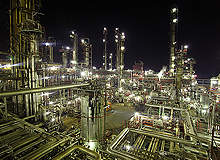
Naftna Industrija Srbije’s (NIS) Pancevo refinery is situated in South Vojvodina, Serbia. The refinery, which began operations in December 1968, has an annual processing capacity of 4.8Mt of crude. It produces petrol, diesel, jet fuel and fuel oil.
The refinery underwent a €547m modernisation programme that enables it to produce Euro 5-quality petrochemical products. The capacity of the refinery, however, remains the same. The project was completed in November 2012. It increased NIS’ total revenues by €270-300m annually. Production of the refinery will increase to 638,000t of Euro-5 standard gasoline and 1.538mt of diesel from 2013.
Construction and infrastructure
The Pancevo refinery was originally constructed with a capacity of 4,000t/d. In 1978, new crude processing units were added to increase the capacity to 10,600t/d.
The refinery currently consists of an atmospheric crude oil distillation unit, hydrodesulpharisation unit, gas treatment unit, naphtha redistillation unit, vacuum distillation unit, fluidised-bed catalytic cracking unit, bitumen unit, alkylation unit and sour water treatment unit. An aromatics extraction unit, vise breaking unit and merox units also make up the refinery.
Extension
Construction and upgrade works on the fuel production units commenced in July 2010. The building permit for the modernisation programme was obtained in December 2010.
The programme involved construction of eight new units and 19 auxiliary units. The new units included a hydrocracking and hydroprocessing complex, a hydrogen production unit, catalytic reforming unit, isomerisation unit, sulphur recovery unit, water stripping unit, amine regeneration unit and a spent sulphuric acid recovery unit.
A number of auxiliary units were added to the refinery, including a nitrogen generation unit, fuel gas system, storage tanks, gas treatment unit, cooling water system, pump stations and other utilities.
The hydrocracking and hydroprocessing complex helps to remove the maximum amount of sulphur, mercaptane and other chemicals from the crude oil. This significantly increases the quality of refined products and reduces the harmful emissions produced by them.
The hydrogen production unit uses natural gas as feedstock and have a capacity of 47,00m³/h. The unit features pressure swing absorption.
Partners
In 2009, Gazprom Neft acquired 51% interest in NIS. Following the acquisition, Gazprom had planned to invest €500m in upgrading NIS’ processing facilities.
In 2011, the Serbian crude oil refining and processing market opened up, as a result of which NIS lost its monopoly in the market. The upgrade programme improves NIS’ competitiveness and makes it a major player in the Balkan region once more.
Contracts
ABB Lummus Global carried out the front-end engineering and design for the modernisation programme between 2003 and 2004.
Foster Wheeler won the design package for the hydrogen unit of the refinery in June 2005.
In October 2009, Chicago Bridge & Iron was awarded a contract worth $70m by NIS to provide engineering, procurement and construction management services for the hydrocracking and hydroprocessing complex. The contract also included construction of auxiliary units, utilities and offsites.
Modification of the vise breaking unit was carried out by Technip / Petrolinvest. Petrolinvest also provided design and engineering services for the offsite facilities and cooling towers.
A partnership between WIG and SMAR was responsible for the construction of the isomerisation unit. The two companies also supplied metering systems for the refinery’s jetty.
Heurtey Petrochem won a €79m contract to supply two refining heaters for the hydrocracking unit. The heaters were delivered between September 2011 and January 2012. In August 2010 Jacobs Engineering Group was subcontracted by Heurtey to provide engineering services for the project.
Siemens was awarded a contract in May 2010 to install a control system for transporting oil and oil derivatives between the pier and the refinery.
PetroProcess installed pumps for the refinery’s road-truck pipeline and also upgraded the Continuous Emissions Monitoring Systems in 2008. The company had installed control valves at the refinery in 2009.



